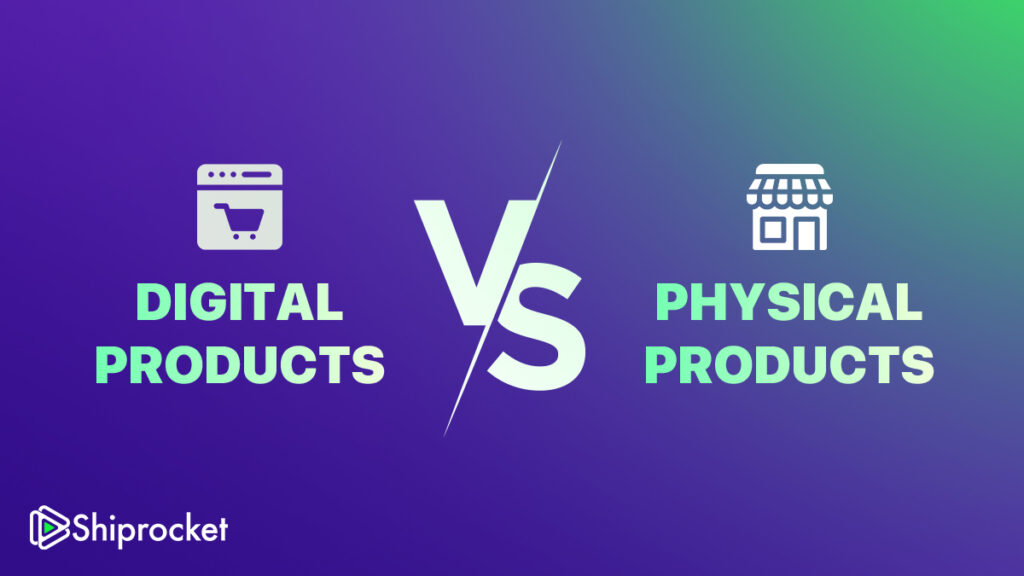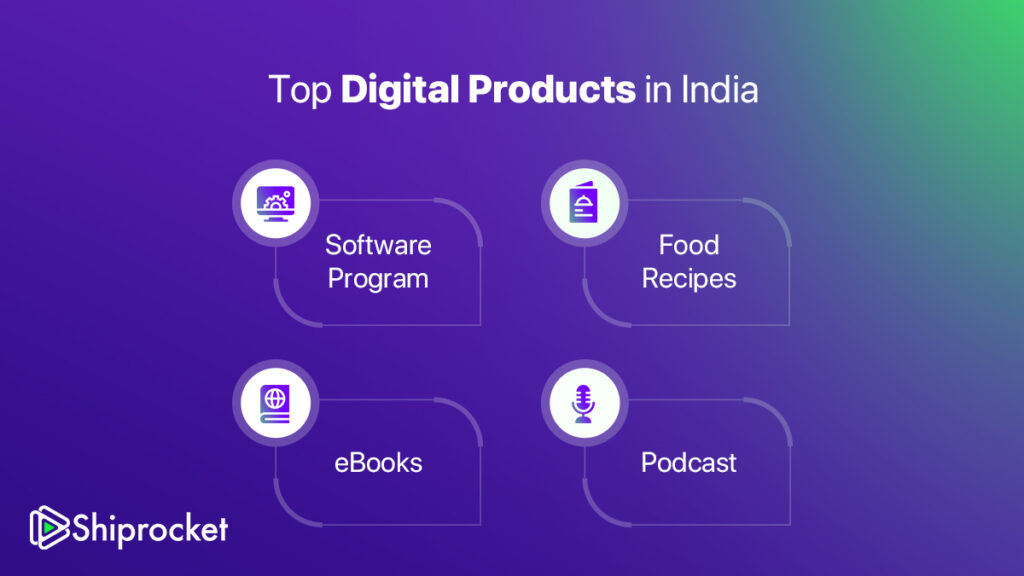12 Most Popular Digital Products to Sell Online (2025)
Digital products like eBooks, online courses, printables, and subscriptions are booming in India with high demand and low overhead costs. Unlike physical products, they don’t require manufacturing, storage, or shipping, making them scalable and profitable. By choosing the right product, pricing smartly, and promoting effectively, you can build a successful digital product business in 2025.
The eCommerce market is diversified; people earn money by engaging in different businesses. The digital product market is booming and offers a highly profitable and scalable business model. A report forecasts that it will reach USD 33,070 million by 2030 at a CAGR of 9.87%. With the increasing demand for online learning, digital downloads, and subscription-based services, now is the perfect opportunity to start selling digital products.
Unlike physical products, digital products need no manufacturing, storage, or shipping, which makes them a lucrative option for sellers who are looking to scale efficiently. More people are tapping into the digital market to create a passive income and expand their brand.
This blog will give you an insight into the top twelve digital products you can sell online and how to get started.
What is a Digital Product?
A digital product is a product that doesn’t have a physical form. It can’t be held in hands and is sold online. For example, you can’t touch an e-book or hold a software program. However, some digital products can be turned into physical products. For instance, you can buy a hard copy of an e-book.
As an entrepreneur who sells digital products in India, your goal should be to create great products and sell them to your existing and new customers. While a digital product is different from a physical one, selling it online is no different from selling a physical one. You need to attract customers, retain them, and offer them the best customer service.
Digital Products VS Physical Products

Physical products have always dominated the market for hundreds and thousands of years. Then you might wonder why you would create a digital product instead of a physical product. Understanding the differences between digital and physical products is important for deciding what to offer. Both have advantages, but digital products present unique opportunities for profitability and scalability. Let’s understand the difference between physical and digital products by understanding their features listed below in the table.
| Features | Digital Products | Physical Products |
|---|---|---|
| Production cost | The production cost is low as it is created once and sold multiple times. | The production cost is high, as it requires raw materials and manufacturing. |
| Storage & inventory | No storage is needed, and it is available/ accessible instantly. | It requires warehousing and inventory management. |
| Scalability | Highly scalable and unlimited copies can be sold. | There is limited production capacity and supply chain. |
| Delivery | Instant downloads or online access are available. | Shipping and logistics are required to deliver products. |
| Profit margins | The profit margin is high as there is no recurring production cost. | The profit is low because of production, storage, and shipping expenses. |
| Risk of damage | No risk of damage or loss | Can be damaged, returned, or lost in transportation. |
| Customer engagement | Mainly is a self-service, but updates and support can be required. | Needs hands-on service and handling. |
What Are the Most Profitable Digital Products to Sell Online in India?
India is one of the world’s widest customer bases. As internet penetration increases in customers, more and more consumers are turning to digital products, making it a perfect opportunity for you. Here are some of the top digital products that you can sell in India in 2025:

eBooks
eBooks have gained a lot of popularity as digital products. The eBook market in India is projected to reach USD 255.36 million in 2025, driven by increasing smartphone and Kindle users. eBooks on topics like personal finance, self-improvement, finance, and career growth are in high demand. You can write on any topic and sell it online. The best part is that this offers passive income, which you can earn throughout the months and years. The eBook’s subject, length, and content depend entirely on you. Some writers also prefer to create series. You can sell them individually – it will provide you with an opportunity to upsell. There are self-publishing platforms like Amazon Kindle Direct Publishing (KDP) to make it easy to create and sell eBooks without any high upfront costs.
Online courses
The Indian e-learning market is expected to surpass USD 10 billion by 2025. Students and professionals constantly looking for skill development in coding, business, design, language learning, etc., have increased the demand and sales of online courses. Platforms like Teachable, Coursera, Graphy, and Udemy allow you to create and sell courses easily.
Printables
Printables like planners, budget trackers, templates, study guides, spreadsheets, etc., are becoming popular among Indian students. The Indian digital printing market size is expanding continuously and is expected to reach USD 2.9 billion by 2033, with a growth rate (CAGR) of 7.8% from 2025 to 2033. Digital printable products require no inventory and can be sold multiple times with minimal effort.
Mobile Applications
India today has over 1.2 billion mobile users and 600 million smartphone users, making app development a booming industry. From productivity tools to gaming, meditation, and cooking apps, you can independently develop and monetise through in-app purchases and advertisements. While you can charge a fee on your application, you can also offer your customers freemium. This includes in-app purchases for customers willing to pay to access more features. Besides, you can also earn through advertising on your application.
Memberships- Subscription Based
Subscription-based digital products are in high demand, as there has been a 437% increase in subscription-based revenue over the past decade. Membership-based platforms offer exclusive content, premium newsletters, fitness coaching, or stock market insights, generating recurring revenue and making it a stable and scalable business model.
Fonts and Typography Kits
Custom fonts and typography kits are in high demand among designers, marketers, and brands aiming to elevate their visual identity. As businesses place greater importance on distinctive branding, the global font and typeface market—valued at USD 965.4 million in 2021—is projected to reach USD 1,332.99 million by 2031. Offering exclusive font bundles can attract a wide range of industries, from fashion houses to tech startups. These products are not only scalable but also offer digital artists a steady stream of passive income over time.
Design Assets and Graphics
High-quality design assets, including icons, illustrations, and UI kits, are essential for web and app developers. Offering these can attract a wide range of customers looking to improve their digital products’ functionality. Design assets and graphics can be listed on online selling platforms to reach a global audience.
Planners and Templates
Digital planners and templates, including budgeting sheets, meal plans and business strategy formats, offer users a convenient way to stay organized and efficient. These tools have gained immense popularity among productivity seekers, students, and entrepreneurs alike. With minimal upkeep and unlimited resale potential, these products are a low-effort, high-return income stream for creators. The digital planner app market valued at USD 7.8 billion in 2023 is projected to reach USD 25.6 billion by 2031, growing at a CAGR of 17.1% from 2024 to 2031. This indicates the potential for this business.
Stock Photography
Stock photography is a profitable digital product where photographers can license images for commercial or editorial use. With rising demand from businesses for high-quality visuals, this market is expected to grow from USD 3.3 billion in 2020 to USD 4.8 billion by 2028. Platforms like Shutterstock and Adobe Stock enable photographers to earn passive income through repeated downloads.
Music and Audio Tracks
Music compositions and audio tracks are in high demand among content creators, advertisers, and filmmakers seeking unique sound elements. By selling royalty-free music or sound effects, musicians can cater to a wide range of multimedia projects. As these assets can be licensed repeatedly, they offer a sustainable income stream—especially with the global stock music market projected to reach USD 2.03 billion by 2028.
Social Media Templates
Social media templates are in high demand as businesses and influencers seek quick, consistent visual content. Various online design tools make it easy to create and sell these on eCommerce platforms. With the social media market expected to hit a stunning growth of USD 466.56 billion by 2029, the demand for ready-made, customizable templates is growing. Offering niche designs can help sellers stand out and earn passive income in a competitive market.
Meditation Guides
As global interest in mental health continues to grow, digital wellness products like meditation guides are becoming highly profitable. The digital wellness app market is projected to reach USD 26.19 billion by 2030, highlighting the rising demand for such content. Selling guided meditations and wellness PDFs on online platforms allows creators to tap into a health-conscious audience while earning recurring income. Offering niche content (stress relief for professionals or sleep meditations) can help cut through the competition.
How to Sell Digital Products Online?
Selling digital products online is a profitable business idea. Here’s how you can get started:
1. Determine Digital Product
Firstly, decide the type of digital product you want to sell online. You can choose any of the options discussed above – eBook, software, or any other.
2. Create Your Digital Product
The next step is to develop the digital product. This may involve creating, designing, writing, programming, or recording the product, depending on your product’s nature.
3. Set Up an Online Platform
Create an online platform to sell your digital products. Some popular options may include:
- Brand Website: you can create your website using platforms like Payhip, WordPress or Shopify. With this option, you will get more control and flexibility. However, it also requires technical knowledge or assistance to set up.
- Online Marketplaces: you can sell on existing platforms like Amazon, Etsy, and Flipkart- just list your products and sell them. These online marketplaces have built-in audiences, making it comparatively easier for you to reach potential customers.
4. Set Pricing and Payment Options
Determine the pricing strategy for your digital product. Perform market research, consider the value you offer, and set a competitive price. Choose convenient payment options for your target audience such as UPI, credit cards, and PayPal.
5. Create Compelling Product Descriptions
Write engaging product descriptions that highlight the benefits and features of your digital product. You can also consider using high-quality creatives and videos to showcase your product.
6. Market and Promote Your Digital Products
Develop a marketing strategy to promote and reach your target audience. You can consider utilising social media for brand awareness. You can also use other marketing tools like content marketing, email campaigns, influencer collaborations, SEO, and paid advertising to generate product awareness and drive traffic to your product listings.
7. Provide Excellent Customer Support
Last but most important point, offer prompt customer support to give your customers a pleasant experience. Address their inquiries and issues promptly and give them helpful solutions.
What Are Some Tips for Selling Digital Products Successfully?
Selling digital products can be highly profitable for you if you have the right approach. Here are some key tips to increase your sales and grow your business:
- To stand out, focus on offering products that are high in quality, well designed, and provide an excellent user experience.
- Don’t focus or rely on just one platform; sell across different sites and marketplaces to expand your reach.
- Offer free samples or mini-courses to your customers for they to trust you and lead conversions.
- Boost sales with limited-time discounts, exclusive offers, and early bird prices to create urgency.
- Ask satisfied customers to leave feedback or testimonials to build credibility and increase conversions.
Conclusion
The demand for digital products is growing rapidly while providing low-cost and high-margin business opportunities. Whether it’s eBooks, subscription-based memberships, or online courses, digital products provide passive income potential and scalability opportunities. By choosing the right product, using smart marketing strategies, and optimising customer experience, you can build a successful digital product business in 2025.
So, are you ready to start selling digital products online? Explore the best platforms and strategies today to turn your ideas into profit!
Yes. With increasing internet penetration, more people are buying eBooks, online courses, templates, and apps, making digital products a profitable low-investment business.
Not always. While app development or software may require coding, products like eBooks, templates, and courses can be created with minimal technical knowledge using online tools.
You can use your own website for full control or sell through marketplaces like Amazon, Etsy, Udemy, or app stores to access built-in audiences.






